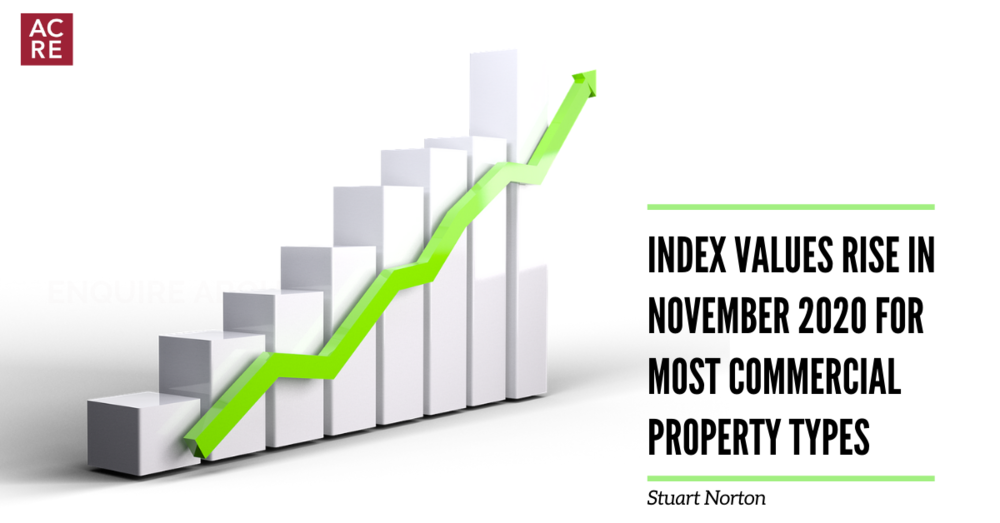Driven by higher valuations for 9 of 13 categories, the Green Street Commercial Property Price Index* (CPPI) for all property types increased 1.8% month-over-month in November. However, the index is down 8% from pre-covid levels, and 11 of 13 property types have lower index values than one year ago. Industrial and manufactured home parks are the two property types with rising valuations since the onset of the pandemic.
Industrial is the best performing property type post-pandemic. Index values show a 10% increase from one year ago and an 8% increase from pre-covid levels. Online sales have grown significantly in 2020, driven by the stay-at-home culture of the pandemic. The growing demand for industrial warehouses to serve logistics operations and last-mile delivery has contributed to rising industrial property values, which were already trending upwards before the pandemic.
Manufactured home parks are the only other property type to show rising index values in 2020, rising 12% year-over-year and 8% from pre-covid. While commercial real estate sales overall declined 68% during the second quarter of 2020, manufactured home park sales increased 23% to over $800 million during the same period. Institutional investors are attracted to the parks because of their generally stable returns, driven by ground lease payments from park residents.
Peter Rothemund, managing director at Green Street Advisors, said, “Property pricing has firmed up over the past few months. In several sectors it’s above, or close to, pre-Covid levels and only the harder-hit property types remain down 10% or more. With interest rates this low—and a vaccine coming—that’s not surprising. Cap rates that are, on average, in the 5% range look very attractive when BBB-rated corporate bonds yield around 2%, or perhaps 3% if one really stretches on term.”
The core sector index, which is calculated based on an equal weighting of apartment, industrial, office, and retail, increased 1% from the prior month, while it is down 6% from both pre-covid and the last 12 months.
The lodging sector has been most affected by the pandemic, falling 25% from pre-covid levels and one year ago. Generally speaking, luxury hotels have suffered the greatest impact, especially those that were dependent on conferences, large groups, and international guests. Economy and mid-scale hotels, on the other hand, have fared somewhat better as their operations have been disrupted to a lesser degree. Value and mid-price hotels located near interstates, for example, can accommodate essential workers who require travel such as transportation, construction, and healthcare professionals.
The mall sector was struggling coming into the pandemic, and has suffered the largest declines in value among all property types, falling 28% year-over-year. Some mall owners have bought out struggling retailers in an attempt to preserve anchor tenants. The Brookfield Property Group and the Simon Property Group, for example, recently purchased JCPenny out of bankruptcy. Additionally, Green Street Advisors predict that half of mall-based department stores will be forced to close by 2021, leaving many large vacancies. Mall owners will have to get creative to find new uses for this glut of vacant space.
*Indexed to 100 in August 2007
**All Property: retail (20%), office (17.5%), apartment (15%), health care (15%), industrial (10%), lodging (7.5%), net lease (5%), self-storage (5%), manufacturing home park (2.5%) student housing (2.5%)





